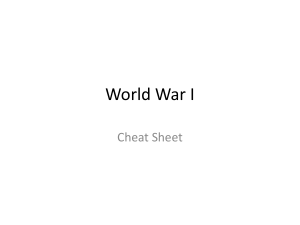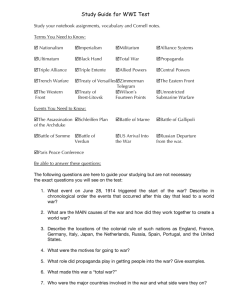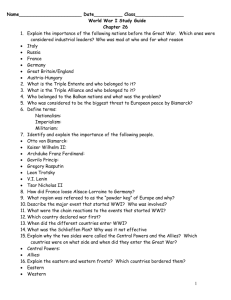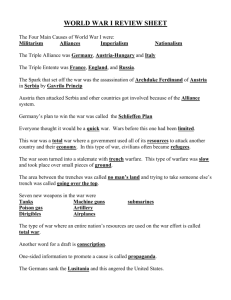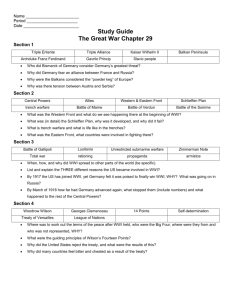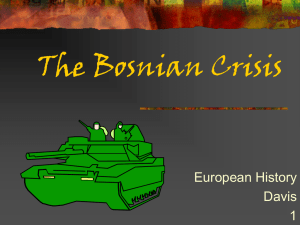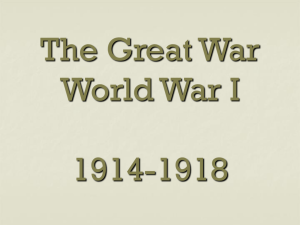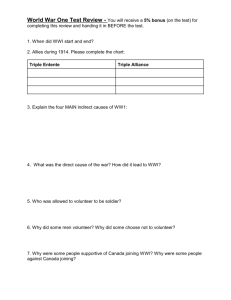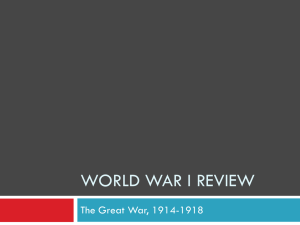WWI
advertisement
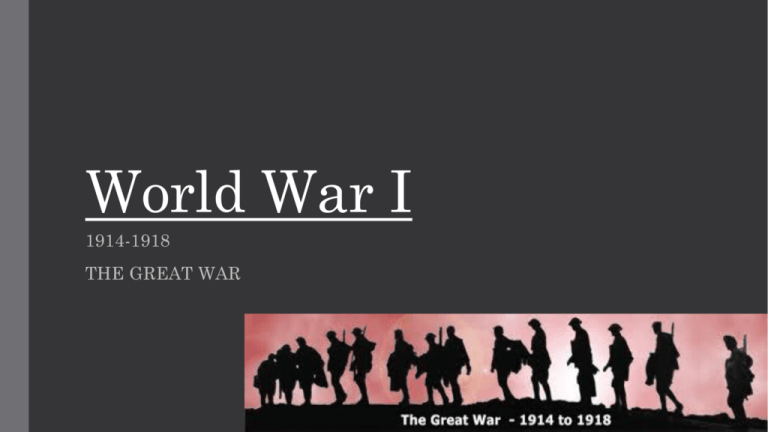
World War I 1914-1918 THE GREAT WAR Unit 4 Enduring Understandings 1. Nationalism, imperialism, militarism, and alliances propelled the industrialized nations of the world into a devastating and global conflict. 2. Advancements in technology changed the nature of war. very 3. Cooperation among nations may not necessarily be fair for all parties involved. Unit 4 Essential Questions 1. When, if ever, should nations go to war? 2. Could World War I have been prevented? 3. Does the advancement of military weapons and technology lead to the devaluation of human life in war? 4. Who was to blame for World War I? What was World War I? *World War I was a largely European conflict that eventually affected many parts of the globe. *The actual war spanned from 1914-1918. *Fighting was between the Allies (initially the Triple Entente) and the Central Powers (initially the Triple Alliance). *The Allies – Great Britain, France, Russia and the USA (minor parties included Italy, Japan, Romania, Serbia, Belgium, Greece and Portugal.) *The Central Powers- Germany, Austria, Turkey, Bulgaria. * Total Mobilized- 65 Million People * Total Casualties-37 Million People * Total Killed- 8.5 Million People (16 Million including civilians) Background • The eras of Nationalism and Imperialism, both beginning to peak in the mid to late 1800’s and early 1900’s created an atmosphere of competition and tension, with the countries of Europe often seeming on a collision course with each other. • Gaining the most political and military power were Britain and Germany. • Britain had also gained the most territory through imperialism of any European nation, but Germany was starting to challenge them on this front as well. Background * Competition was becoming fierce on all fronts for who would emerge as the dominant colonial, industrial, economic and military power. * Efforts to control these competitive forces were undermined by the Scramble for new lands, fierce pride in one’s nation, and secret treaties between countries “just in case” war broke out. Background ~ Germany • Under the leadership of Kaiser Wilhelm II. His father had been instrumental in the unification of Germany with the guidance and assistance of Bismarck. • Bismarck had viewed treaties as a way to ensure stability for Germany. • Wilhelm the II was not the statesmen that his father or Bismarck was. He fired Bismarck and let a key treaty with Russia lapse. • However, he did join the Triple Alliance, a “mutual defense” treaty between Germany, Austria-Hungary and Italy. Background ~ Britain • Had been the “winner” in the race of imperialism- “The Sun did not set on the British Empire” that Queen Victoria had forged. • Britain had also been the most dominant economic superpower gaining this advantage with the head start they had in the Industrial Revolution? • Following the Death of Queen Victoria, King George V ascended to the throne. • King George was first cousins with King Wilhelm II of Germany and Czar Nicholas II of Russia (but Willie and Nicky were second cousins, while Willie and Nicky’s wife Alexandra were first cousins) • The Prime Minister at the time war broke out was Herbert Henry Asquith (until 1916 where he is replaced by David Lloyd George). • Britain was allied with France and Russia via the “Triple Entente” Crazy Cousins Tsar Nicholas II of Russia Keiser Wilhelm II of Germany King George V of England Queen Victoria’s Family Tree Background ~ Russia • Was not a modernized nation like those of Western Europe • They had not experience the Industrial Revolution, nor had they participated in aggressively expanding their territory for purposes of Imperialism. • Russia had a huge population but was still existing in an archaic feudal system, with serfs and peasants existing at or near poverty and accounting for the majority of the people. • At the start of WWI, Russia was ruled by Czar Nicholas II • Russia saw itself as the protectorate of the Slavic People (including tiny little Serbia, which was part of the Balkans) • Russia also had a secret treaty with Serbia Background ~ The Balkans • The Balkans were an area of great interest for both Russia, Austria Hungary and the Ottomans. The Balkans had been controlled by the Ottomans, but were now in part under Austrian Control- specifically Bosnia. • So much turmoil earned the Balkans the nickname, the “Powder Keg of Europe”. • A movement to free Bosnia from Austrian control had been centered in Serbia with an organization known as “The Black Hand” • June 28th, 1914- An assassin of the Black Hand, Gavrillo Princip, changed world History when he killed Archduke Franz Ferdinand and his wife on their royal visit to Sarajevo, the capital of Bosnia. Bosnia and the Balkans Setting the Stage to War I. Pressure for Peace a. During the Late 1800’s and early 1900’s there were several attempts made to end war as an “instrument of foreign policy”. 1. 2. 3. 4. Alfred Nobel- Made yearly prize for peace Women’s Suffrage- Aletta Jacobs- Argued that if women could vote, there would be no war Women’s international League for Peace First Universal Peace Conference (1899) ~ Established the World Court at The Hague in the Netherlands- Countries would have to settle disputes in Court ~Problem- Not enforceable 5. Powerful • • • • Forces push Europe Towards War: Nationalism Economic Competition (Industrial Rev. & Imperialism) Arms Race (Militarism) Alliances Setting the Stage, continued… II. Aggressive Nationalism ~ Europe battles over disputed lands A. B. Alsace and Lorraine- Germany occupied these areas along the French-German border after gaining them from France in the Franco-Prussian War. France still claims the areas as there own. Pan Slavism-Russia promoted “Pan Slavism”- and proclaimed itself as the protectorate of all Slavic People, stating that they were a “common nationality”. C. Crisis in the BalkansA. Austria-Hungary- Feared Slavic Revolts B. Ottoman Empires- Fears Serbian aggression C. 1912- Several Balkan States Attack Turkey (the Ottomans) D. Balkans- Dubbed “The Powder Keg of Europe” D. Economic and Imperial RivalriesA. Britain- Intimidated by Germany’s new industrial power, aggressive nature, and massive military build up B. Germany- feels it is not being respected C. France/England- dispute Germany over African Colonies Setting the Stage, continued… E. Militarism1. Militarism- glorification of the military- readiness for war dominates national policy -war is presented as glorious -patriotism and heroism are pushed in schools 2. The Arms Race= Tension “One day the great European War will come out of some damned foolish thing in the Balkans (1888).” ― Otto von Bismarck Shot Rings Throughout Europe I. One single murder- Millions of Victims! A. Archduke Franz Ferdinand, heir to the Austrian Empire, visits Bosnia to sure up ties between Austria and Bosnia. - Serbia is not happy with this, they want Bosnia to break away from Austria. B. Franz Ferdinand and his wife Sophie are assassinated on June 28, 1914 by Gavrilo Princip, a member of the “Black Hand”, an organization that promoted the unification of Serbia and Bosnia. C. The Assassination plot appears to have initially failed and then by chance, Franz Ferdinand is the “Wrong Place at the Right Time” Shot Rings Throughout Europe II. Austria seeks “Justice” A. Austria holds Serbia responsible for the actions of Princip and the Black Hand B. Austria issues Serbia an Ultimatum with a list of ten demands including: 1. The Suppression of all publications critical of Austria- Hungary and withdrawal of all school books critical of the A-H Empire. 2. Dismissal of all Teachers and Gov’t officials critical of the Empire 3. The arrest of anyone associated with the Black Hand or Assassination 4. The appointment of an Austrian Official to monitor the fulfillment of all of these demands.* * The Serbian’s accepted all of these demands except for this last one C. Austria Declares war on Serbia on July 28, 1914 Shot Rings Throughout Europe III. Tangled AlliancesA. Kaiser Wilhelm II of Germany was outraged at the murder and encourages Austria to go to war. B. Wilhelm II says Germany will issue Austria a “Blank Check”- anything that Austria needs, Germany will provide. C. Nicholas II of Russia tries to reason with his cousin Wilhelm II. They exchange a series of now famous telegrams known as the “Nicky-Willie telegrams.” Willie falls short of comprehending the situation and refuses to help. D. Russia Mobilizes- prepares its military and sends their troops to the Russian border with AustrianHungary. E. Russia appeals to France, calling upon its Alliance. F. France sees this as a chance to regain Alsace Lorraine. G. Germany Declares war on France. H. Belgium, Italy, and England still neutral Guns of August • What type of war was Germany about to fight? A two front war German Strategy on the Western Front • How could Germany avoid a 2 front war? The Schlieffen Plan The Schlieffen Plan 1. Belgium, Italy and Britain remain neutral- support no sides in the war initially, despite their treaties and alliances with involved parties. (Changes soon thereafter with the invasion of Belgium by Germany.) 2. The Plan- Defeat France before Russia could mobilize *Germany invades France through neutral BelgiumBritain Declares war on Germany. *Italy does not join in, disagreeing with Germany’s offense actions into Belgium New Kind of War How Many Men? * France- 8.5 Million Men * Britain- 9.0 Million Men * Russia- 12 Million Men * Germany-11 Million Men ~One of every 3 men would be killed I. The Western Front a. Trench Warfare- Under the Schlieffen plan Trench warfare would have been unnecessary. BUT, 2 Things happened that caused the Schlieffen Plan to fail miserably: 1.Russia mobilized to the Austrian Front before Germany mobilized, thus they were in place before Germany ever got near Paris 2.Tactical German error allowed for successful French Counter Attack. New Kind of War 2. Winter and endless machine gun fire forces both sides to “dig in”- thus vast networks of trenches to be dug- stretched for hundreds of miles- “From the Swiss border to the English Channel” 3. Trenches become vast networks of bunkers, machine gun emplacements, barracks, barbed wire defenses 4. Different forms of trenches developed (fire, communication, connection, cover) 5. Men waited in the trenches for weeks, waiting for the order * exposed to constant shelling * Subject to disease/ rats/lice/mud * Dead Bodies everywhere 6. “No Man’s land” – Infantry charges- a few to several hundred yards to the enemy trench linehundreds (thousands) die every day in back and forth battles where no territory is gained. ~ Stalemate New Kind of War B. Costly Battles 1. Verdun- Germans vs. France- “They Shall Not Pass”500,000 casualties 2. The Somme- Germans v. Brits- July to November of 1916 The British sustained nearly 60,000 casualties on the first day, 19,200 of which were killed in the fighting. Overall almost 1.5 million casualties were sustained in this 5 month long battle. C. A war of machines (The Industrial Revolution applied to Killing) . 1. new powerful artillery- shoots from miles away, 100 lb. shells 2. machine guns- mass produced on assembly lines 3. Tanks introduced in this war 4. Submarines used for the first time on a widespread scale New Kind of War 5. Airplanes- mostly fighters and reconnaissance * Pilots considered themselves to be like medieval knights 6. poison gas- First major use at the 2nd Battle of Ypres 1915- 4 mile stretch where gas was released * Only 4% of all combat deaths directly related to Gas * However, the most feared weapon of the war * Most common gases- tear gas, mustard gas, chlorine gas, and phosgene gas. WWI Germany on the move- packet pages 13-17 • Complete packet pages with a partner. Be prepared to responses with the class. discuss your Major Battles of WWI Battle of Mons- Aug. 1914-first encounter between Br. and Ger. Br. Retreat. Battle of Tannenberg-Aug. 1914- first battle of E. Front. Huge Rus. Casualties Battle of the Marne (1st)- Sept. ’14 -Germans retreat, Schlieffen plan thwarted Battle of Ypres- Apr.-May 1915 first recorded use of gas warfare. Gallipoli Campaign- Mar.’15-Jan.’16- battle for control of the Dardanelle Sts. ~ fought in Turkey. British forces (inc. Aus. and NZ) fail. Battle of Verdun- Feb-Dec. 1916. Very bloody battle between Fr. And Ger. Forces- battle of attrition. Sole point of Germans was to kill as many Fr. as possible. (Became a snapshot of the war.) Battle of Somme- Jul.-Nov.’16. Massive casualties, 20,000 Br. Soldiers killed. Battle of the Marne (2nd)- July 1918. Allies prevail with help of US. Last real push of Central Powers. WWI WWI featured many events and characteristics that were either unique to WWI or encountered in conflict for the first time …. With the massive scale of the conflict, every problem multiplied in its significance and impact. Images of WWI…. Trenches- From Switzerland to the N. Sea WHAT IS THIS? British Trenches No mans land German Trenches Aerial view of WW1 Loos-Hulluch trench system THE STALEMATE OF TRENCH WARFARE TRENCH WARFARE (The Constant Dangers) • ARTILLERY • DISEASE Lice Trench Foot • CRITTERS Trench foot ATTEMPTS MADE TO OVERCOME THE STALEMATE OF TRENCH WAR Inching Forward • Move forward by building fences in front of trenches TUNNELING CHECK OUT “GAS IN THE TRENCHES” IN YOUR PACKET!!! GAS • Gas warfare can suffocate enemy soldiers • Heavier than air Sinks into trenches and stays there • Gas can… Burn your skin Suffocate you Blind you Gas Attack! Spooky! GAS MASKS ARE NICE… …BUT ONLY FOR YOUR FACE!!! TOO SLOW GETTING HIS MASK ON NEW WEAPONS OF WWI •TANKS •MACHINE GUNS •SUBMARINES •FLAMETHROWER •AIRPLANE •GIANT ARTILLERY WHAT DO ALL OF THESE NEW WEAPONS MEAN FOR TROOPS? “SHELL – SHOCK” “GOING OVER THE TOP” “HORRIBLE RESULTS” MERCILESS SLAUGHTER THE FINEST YOUNG MEN IN THE WORLD… War Footage….. As you watch the following segments on the Battle of Verdun and or the Battle of the Somme What images in the video reflect the impact that Militarism and the Industrial Revolution had on warfare? Battle of Verdun Battle of the Somme Winning the War I. Effects of the Stalemate* Total War- defined~ The channeling of a nation’s entire resources into a war effort- Modern, mechanized (industrial war) requires this A. Economic Impact- 1. “The Draft”- all nations utilize- require young man for involuntary service 2. Taxes raised/ Strikes forbidden/ mandated rationing and recycling B. Propaganda war 1. Propaganda- spreading ideas to promote a cause or damage opposing cause. an * French and Brits- use invasion of Belgium to portray Germans as murderous villains- Huns * Often exaggerated or untrue PROPAGANDA • ENCOURAGE PEOPLE TO JOIN ARMED FORCES • GUILT • MAKE TRIP!!! ENEMY LOOK BAD! WHY GO TO WAR? WWI Propaganda WWI Propaganda Posters More WWI Propaganda Posters Winning the War II. Women at War A. In the workplace, on the factory line- Women step in to keep economies going B. Armed Forces- stationed as nurses near the front line, first hand accounts of the horrors of the “new era in warfare”. III. Collapsing Morale ~ Bankruptcy, desertion, revolution, hunger 1. 1915- Bulgaria joins Central Powers- helps crush Serbia 2. Italy joins the Allies 3. Battle of Caporetto- Austria and Germany crush Italy. 200,000 prisoners of war taken. Winning the War III. War Beyond Europe- A. War and the Colonies in Africa and Asia 1. Allies overran German colonies in Africa and Asia 2. Allies turn to colonies and Britain turns to dominions (Can., Aus., N.Z.) for troops 3. Indians and Africans fight for the Europeans, led to believe that they will be awarded independence B. Non-European Powers 1. 1914- Ottoman Empire joins the Central Powers 2. Battle of Gallipoli~Brits, Australians, New Zealanders, Indians invade Gallipoli peninsula in Turkey ~Goals of the Campaign*Open up the Dardanells- a link to the Black Sea and Russia- supply purposes *Capture Istanbul and knock Ottomans out of the war. Winning the War • 3. After 10 months and 200,000 casualties- invasion is called off by British Japan, allied with Brits, capture German colonies in Asia C. Revolution in Russia 1. War for Russia is a disaster. The Czar continued to send man after man despite huge losses of life. Most were from the Peasant class. As such it was seen as a class war, fueling an up well of resentment and discontent among the peasants. 2. Bolshevik (Communist) revolutions occurs, Czar abdicates 3. Vladimir Lenin (who was brought back to Russia by the Germans) signs the Treaty of Brest-Litovsk- ends Russian involvement in WWI against Germany. * Why is this important for Germany? * How do the other Allies feel about this? Winning the War IV. The U.S. Declares War A. Unrestricted submarine warfare 1. Germany attacks ships with Americans on board- most ships had supplies for the Allies heading to Europe across the Atlantic. 2. May 1915- Lusitania, a British passenger liner sunk- 128 Americans killed * Germany said it had weapons- Germany said it would neutral passenger ships before attack- lied about this warn B. Cultural ties- many British, French, and Russian immigrants in U.S. demand support of the Allies (though some – Italian and German- Want to support the Central Powers)- Remember, the U.S. is a melting pot! Winning the War C. Zimmerman Note 1. Brits intercept message from Germans to Mexico from German foreign secretary 2. Message promises the return of New Mexico, Arizona, Texas for a declaration of war against the U.S. D. U.S. Declares War- April 6, 1917 1. U.S. Presence offsets any advantage gained by Germany with the end of the war in the Eastern Front. 2. U.S. Troops are well equipped and “fresh”- provides for pushing Germany back and winning the war. “ The U.S. Infantry Won the War”when asked “Who Won?” advantage German General at war’s end Making the Peace I. The Costs of War ** Over 8.5 million die ** 17 million wounded A) Financial burdens 1. Towns Destroyed 2. Huge national war debts 3. Allies demanded enemies pay reparations- payments for war damage (blame) (War guilt clause) B) Political turmoil 1. Governments collapse (Rus., Ger., Aus.,Ottoman Empire 2. Conservatives warn against Communism 3. Africans and Asians have new hopes for independence Making the Peace II. The Paris Peace Conference A) The Big Three- 3 personalities dominate the peace conference 1. Woodrow Wilson (USA)- “Peace without Victory”- 14 Points 2. David Lloyd George (G.B.)- Demands harsh treatment for Germany 3. Georges Clemenceau (France)- Badly weaken Germany- so can not threaten France again B) Difficult issues1. Secret Alliances- groups at the negotiations have formed partnerships to help each other get what they each want. 2. England and France want to punish Germany and exact payment from them for war costs and damages. 3. Italy makes push for lands once owned by Austria- contradicts Wilson’s concept of “self determination” (people pick gov. type) 4. Groups argue over new borders Making the Peace III. Treaty of Versailles- Treaty of Versailles (8 min. video) A. June 28, 1919- German representatives invited to Versailles. *Who are these representatives? B. C. The Big Three order the German Representatives to sign the peace treaty. The Treaty- Key provisions: 1. War Guilt Clause- Germany forced to accept full and total blame for the war. 2. Reparations- Germany required to pay for the war damages to the Allies- 30 Billion Dollars. 3. Limited Military- German military restricted to 100,000 men, 6 Warships, no submarines, and no planes 4. Alsace and Lorraine- Returned to France 5. German Colonies- Colonies placed into the mandate system 6. Demilitarized Zone- Land between France and Germany required to remain demilitarized- a neutral buffer zone. The Rhineland. Making the Peace D. Disaster- The overall effect of this treaty was to create an era of international tension for 20 years that directly leads to WWII. ~ In the end, Wilson’s plan for a lasting peace is ignored. He did not believe in punishing Germany, but in encouraging support for the fledgling democratic government. ~Germany - no chance for the Weimer Republic to succeed How can a country who has been beaten and destroyed, that needs to rebuild its cities, infrastructures, and society have money to pay to other countries? ~ The desperate and bitter state created by this document in Germany and the bitterness in Italy from not being rewarded for their efforts allow for the rise of fanatical dictators- Hitler and Mussolini. Making the Peace IV. Other Settlements and provisions of the Treaty: A) Self Determination in action- new nations created: 1. Poland 2. Czechoslovakia 3. Austria 4. Hungary 5. Yugoslavia B) Mandate System ~Colonial Territories gained in Imperialism are expected to end. Interim governing responsibility to fall under the newly created League of Nations Winning the Peace C) Wilson’s Plan for Peace 1. Wilson proposed 14 points for peace. Designed to rebuild Europe and create a stable world. France and England rejected all of the points except for 1- The League of Nations. 2. U.S. Congress would not approve U.S. as a member of the League ~Why not? 3. Wilson predicts that the new treaty would result in another global conflict with in 20 years. ~Was he right? Conclusion IN ONE WORD, HOW WOULD YOU DESCRIBE WWI? • WWI IN ONE WORD
